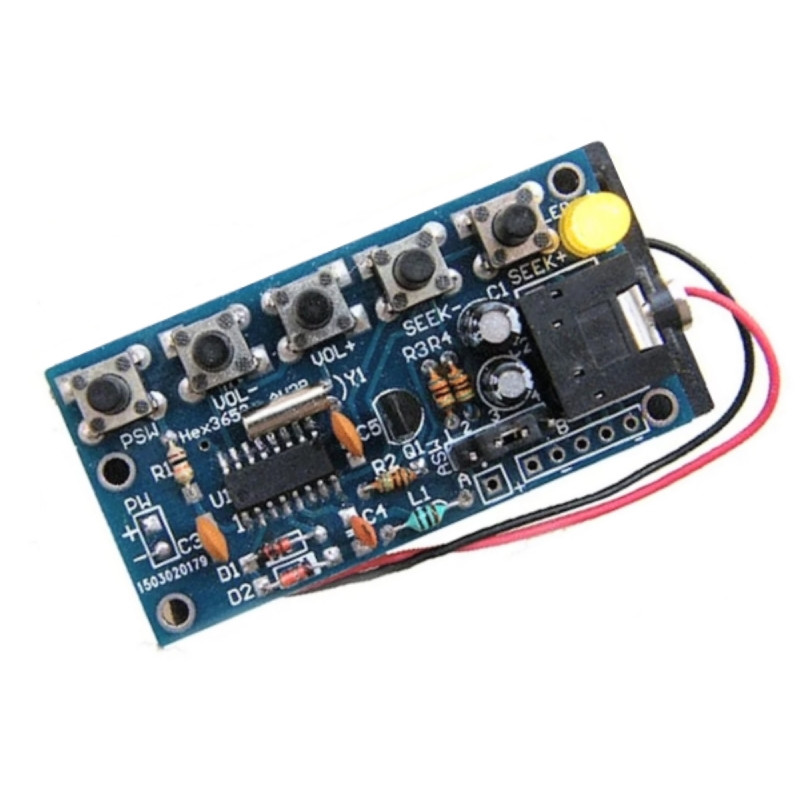





Based on the Hex3653 chip, this kit allows you to create a stereo mini FM radio (76 ÷ 108 MHz) that can be powered by two simple AA batteries.
 Secure Payments
Secure Payments
Pay safely with Credit Card, PayPal, Amazon Pay or Bank Transfer
 Fast Shipping
Fast Shipping
We ship across Europe and worldwide with UPS, DHL and DPD
 30-Day Easy Return
30-Day Easy Return
You have 30 days from delivery to return the product if you're not satisfied
Attenzione, il prodotto è un KIT e pertanto vi verranno consegnati i componenti da saldare con un saldatore per elettronica e tutto l'occorrente per ricreare l'apparato come da immagine. Nel KIT sono comprese istruzioni illustrate in lingua inglese di facile comprensione.
LIVELLO ESPERIENZA NECESSARIO medio-alto (componenti SMD da saldare)
Disponibile anche il montaggio e collaudo da parte di Mectronica STORE aggiungendo quantità 20 del Servizio montaggio KIT acquistabile cliccando qui su EBAY | MECTRONICA STORE ed aggiungendolo al carrello insieme al KIT da montare.
Basato sul chip Hex3653, questo kit permette di realizzare una mini radio FM (76÷108 MHz) stereo alimentabile tramite due semplici pile stilo. Utilizza pochissimi componenti esterni come: pulsanti di controllo, resistenze, condensatori, transistor e LED.
I pulsanti consentono la regolazione del volume (VOL- e VOL+), la ricerca delle emittenti (SEEK- e SEEK+), accendere o mettere in standby il dispositivo (PWS). La sintonia spazia tra 76 e 108 MHz a passi tipicamente di 50 kHz, l’estensione della banda FM sintonizzabile è stata pensata per coprire tutte le bande radiofoniche a modulazione di frequenza previste nel mondo. In Italia e in genere in Europa la gamma FM spazia tipicamente fra 87,6 e 108 MHz.
Dispone inoltre di presa jack stereo da 3,5 mm per l’ascolto in cuffia ed anche un connettore pin-strip, che consente il collegamento a un amplificatore audio stereo esterno.
Come antenna può essere utilizzato sia il filo della cuffia o auricolare (esattamente come avviene con la radio FM integrata in telefoni cellulari e smartphone) sia un’antenna a parte (a filo o a stilo).
N.B. batterie, cuffia e antenna non incluse (vedere prodotti correlati).
Caratteristiche tecniche
L’integrato Hex 3653
Si tratta di un completo radioricevitore FM in tecnologia CMOS incapsulato in contenitore plastico SOP 16 pin, con stadio di sintonia a sintesi digitale quarzata (mediante quarzo da 32,768 kHz) con reiezione dell’AM di 40 dB, decoder stereo multiplex e controllo digitale del volume.
Completa la dotazione del componente un regolatore LDO che ricava la tensione stabilizzata per tutti gli stadi, partendo dalla tensione applicata tra il pi Vcc e il GND.
Il chip si alimenta fra 1,8 e 3,6 Vcc e assorbe tipicamente 17 milliampere (senza il LED) con uscite collegate a uno stadio ad alta impedenza.
L’uscita stereo è accoppiata in continua (non a caso richiede condensatori di disaccoppiamento) ed è a bassa impedenza e tipicamente accetta carichi da 32 ohm a 1 kHz, ovvero è collegabile a ingressi ad alta impedenza di preamplificatori e amplificatori audio.
Il decoder stereo consente una buona separazione dei canali, tipicamente di 35 dB, mentre le uscite audio garantiscono una bassa distorsione armonica, che spazia tra lo 0,05% e l’1% al massimo del volume. Il rapporto segnale/rumore arriva a circa 60 dB, quindi è più che accettabile.
Based on the Hex3653 chip, this kit allows you to create a stereo mini FM radio (76 ÷ 108 MHz) that can be powered by two simple AA batteries. Very few external components used such as: control buttons, resistors, capacitors, transistors and LEDs.
The buttons allow you to adjust the volume (VOL- and VOL +), search for stations (SEEK- and SEEK +), switch the device on or standby (PWS). Tuning ranges from 76 to 108 MHz in typically 50 kHz steps, the tunable FM band extension has been designed to cover all radio bands and expected frequency modulation in the world. In Italy and generally in Europe the FM range typically ranges between 87.6 and 108 MHz.
It also has a 3.5 mm stereo jack socket for listening with headphones and also a pin-strip connector, which allows connection to an external stereo audio amplifier.
Both the headphone or earphone wire (exactly as with the FM radio integrated in mobile phones and smartphones) and a separate antenna (wire or stylus) can be used as antenna.
N.B. batteries, headphones and antenna not included (see related products).
Technical features
• Power supply voltage: 3 Vdc
• Current consumption: 30 mA
• Tunable frequency: 76 ÷ 108 MHz
• Headphone output: 32 ohm
• Audio output: 200mVeff
• Modulation: FM
• Decoding: stereo with 35 dB separation
• Digital tuning: push-button
• Volume control: digital
The integrated Hex 3653
It is a complete FM radio receiver in CMOS technology encapsulated in a 16-pin SOP plastic case, with digital quartz synthesis tuning stage (using 32.768 kHz quartz) with 40 dB AM rejection, multiplex stereo decoder and digital volume control .
The component is completed by an LDO regulator which obtains the stabilized voltage for all stages, starting from the voltage applied between the pi Vcc and the GND.
The chip powers between 1.8 and 3.6 Vdc and typically draws 17 milliamps (without the LED) with outputs connected to a high impedance stage.
The stereo output is DC coupled (not surprisingly it requires decoupling capacitors) and is low impedance and typically accepts loads from 32 ohms to 1 kHz, meaning it can be connected to high impedance inputs of audio preamps and amplifiers.
The stereo decoder allows for good channel separation, typically 35 dB, while the audio outputs and low harmonic distortion, which ranges between 0.05% and 1% at maximum volume. The signal-to-noise ratio comes in at around 60 dB, so it's more than acceptable.
You might also like